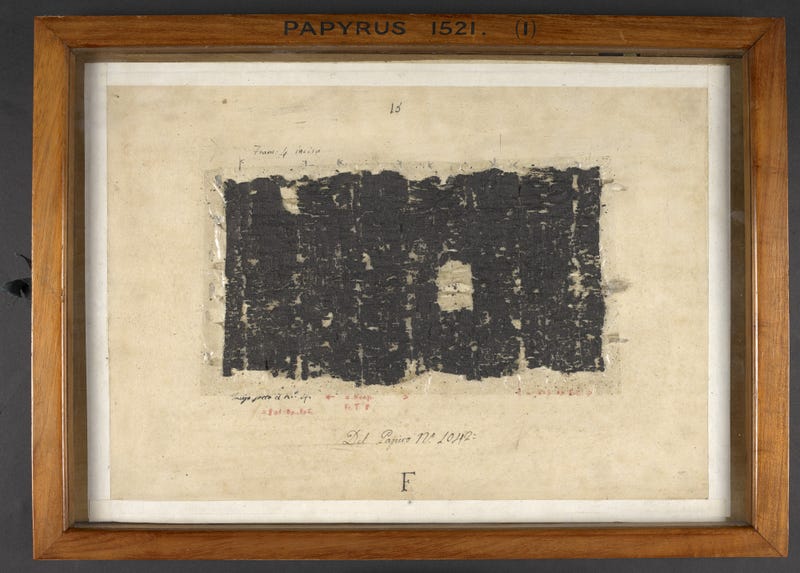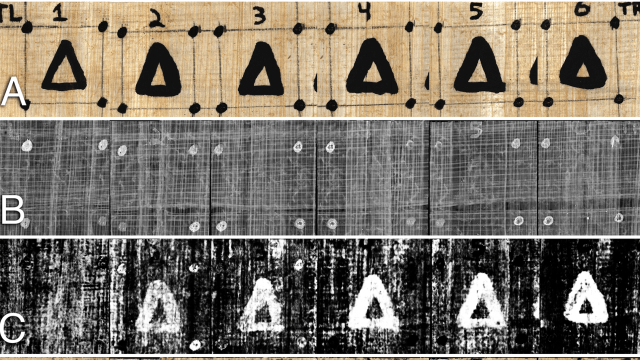The first word found and translated from an unopened carbonised scroll from the Roman town of Herculaneum was announced last week, as part of the $US1,000,000 Vesuvius Challenge to read the papyri from the settlement that was buried by the eruption of Mount Vesuvius in 79.
The word was purple. It was found first by Luke Farritor, who won $US40,000 for his efforts, according to a release on the challenge’s website. Youssef Nader independently found the same word later, taking home the second place prize of $US10,000.
The Herculaneum scrolls are inked documents that were in Herculaneum’s Villa of the Papyri when Mount Vesuvius erupted in 79, burying the town and its more famous neighbour, Pompeii, in volcanic ash. The devastation was swift, but it also preserved both towns immaculately, and they lay undisturbed until the 18th century. The carbonised scrolls were found in 1750 by a farmworker, but given their fragility, early attempts to unwrap them caused their destruction. Several of the scrolls were later unrolled—over decades by an Italian monk—but over 600 remain unopened.
“These texts were written by human hands at a time when world religions were emergent, the Roman Empire still ruled and many parts of the world were unexplored,” said Brent Seales, a computer scientist at the University of Kentucky and principal investigator of the Digital Restoration Initiative, said in a university release. “Much of the writing from this period is lost. But today, the Herculaneum scrolls are unlost.”
Now, the technology to read at least some of the writing without harming the scrolls is here. In 2015, a team from the University of Kentucky managed to read a Dead Sea scroll without opening it, using X-ray tomography and computer vision to create a 3D model of the scroll (complete with writing) that could be virtually unwrapped.
The program is called the Volume Cartographer, and uses micro-CT imaging to produce high-resolution images of the characters inside. Document scanning technologies often detect metals in the ink to discern written (but concealed) lettering from the surface on which it was written.
But the Herculaneum ink is carbon-based, so the researchers developed a neural network to identify patterns in the data of the scan that indicated the presence of ink from the unmarked parts of the papyrus. Research describing the process to recover the Herculaneum ink was published in 2019.

The recently ‘unwrapped’ scrolls are housed in Paris’ Institut de France, and are some of the documents excavated some 275 years ago. According to the release, the documents are thought to have belonged to a Roman statesman.
X-rays can be used to understand various aspects of ancient documents. In 2022, a team from the SLAC National Accelerator Laboratory blasted parts of a Gutenberg bible and an early Korean text with X-rays to better understand how the documents were printed, in an effort to learn how printing technology was discovered and implemented around the world.
Earlier this year, a different team of researchers used X-rays directly on the 2,000-year-old remains of Pompeii victims, to try to better understand exactly what killed them. X-ray fluorescence was used to study the chemical composition of the victims’ bones, which led the team to conclude that the individuals they studied asphyxiated due to toxic gases rather than superhot pyroclastic flows and magma currents.
The grand prize of the Vesuvius Challenge is $US150,000, to be awarded to the first individual to read four passages of text from the scrolls’ inner layers by the end of the year. The patient, hands-off work to read the Roman scrolls is paying off… especially to those quick enough to decipher the carbonized carbon ink at the scrolls’ cores.
